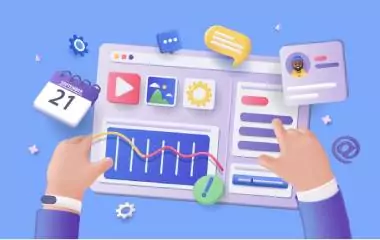Photo by Jonathan Borba on Pexels
Aspiring graphic designers often face challenges in honing their skills, grappling with complex design concepts, and finding the right tools to bring their creative visions to life.
Without the proper guidance and resources, the journey from a novice to a proficient graphic designer can be overwhelming and discouraging.
Enter graphic design software—a powerful ally that simplifies the learning curve, enhances creativity, and empowers designers to achieve professional-level results. Graphic design software has revolutionized the design industry, providing many tools and features catering to all levels of designers.
In this article, we will explore how graphic design software can elevate your skills from the novice stage to becoming a seasoned professional. Let's dive in and uncover the transformative impact of these tools on your creative journey.
How Graphic Design Software Enhances Novice Skills
As a beginner, stepping into graphic design can be thrilling and daunting. Graphic design software comes to the rescue, providing user-friendly interfaces, abundant learning resources, and a platform to practice design principles, nurturing novices into confident designers.
User-friendly interfaces for beginners
User-friendly interfaces in graphics software such as Plasfy, Adobe Creative Suite, and Canva have been thoughtfully designed to cater to beginners, eliminating the intimidation factor often associated with complex tools. With their intuitive layouts and user-friendly menus, novices can quickly navigate various tools and functions.
Moreover, the presence of pre-designed templates and drag-and-drop functionality is a game-changer for aspiring designers. These handy features allow novices to jumpstart their design projects without needing advanced technical skills.
Accessible learning resources and tutorials
Graphic design software caters to beginners with a wealth of accessible learning resources, step-by-step tutorials, and top training video software. Extensive documentation ensures novices can grasp essential design techniques and principles effortlessly.
Additionally, thriving community forums and user groups create a supportive environment for beginners to seek guidance, share experiences, and gain valuable insights from seasoned designers.
Practicing design principles and basic techniques
With graphic design software, novices can actively engage in hands-on practice of essential design principles and techniques. They can seamlessly translate theoretical knowledge into tangible visual creations through experimentation with composition, balance, and contrast.
The software's real-time previews and instant feedback mechanisms are invaluable learning platforms.
Developing an eye for aesthetics and composition
Frequent utilization of graphic design software nurtures a designer's discerning eye for aesthetics, empowering them to craft visually captivating designs that deeply connect with their audience. The software's constructive tools, such as grids and alignment guides, are pivotal in cultivating a keen sense of balance and harmony within designs.
These features assist designers in precisely arranging elements, achieving optimal proportions, and orchestrating captivating compositions.
Intermediate Level: Building on the Basics
Now that you've graduated from a novice into a more experienced designer, it's time to delve deeper into graphic design or even pursue a career as a graphic designer. Based on data from the Bureau of Labor Statistics, the median annual income for graphic designers stands at approximately $50,710.
At the intermediate level, graphic design software becomes your faithful companion in mastering advanced tools, refining techniques, and crafting designs that truly stand out.
Mastering advanced tools and features
Graphic design software empowers designers with diverse advanced tools, including powerful image manipulation capabilities, versatile vector graphics tools, and a plethora of creative effects. These sophisticated features elevate designs to new heights of creativity and professionalism.
By mastering essential techniques like layers, masks, and blend modes, designers gain greater control over their compositions, producing intricate and visually stunning artworks that captivate their audiences with finesse and skill.
Incorporating typography effectively
At the intermediate level, designers focus on honing their typography skills, discovering the art of harmoniously pairing fonts to convey the desired tone and mood. They fine-tune the spacing between characters (kerning), lines (leading), and words (tracking) to enhance readability and visual appeal.
Typography also involves elements such as gradient text effects and font color and transparency. By skillfully crafting typographic hierarchy, they guide viewers' attention and emphasize key design elements.
Understanding color theory and palettes
A deep understanding of color theory and palettes is vital for intermediate designers, and graphic design software is a crucial enabler. Through intuitive interfaces, designers can freely experiment with diverse color combinations, gaining insights into different hues' emotional impact and symbolism.
The availability of color swatches and pickers further streamlines the process, allowing designers to maintain visual coherence and consistency in their designs.
Working with layers and non-destructive editing
In the intermediate phase of their graphic design journey, designers fully embrace the potential of working with layers and non-destructive editing. Layers serve as a versatile organizational tool, allowing them to structure design elements efficiently and create complex compositions seamlessly.
With non-destructive editing, designers can experiment fearlessly, as any changes to their artwork remain separate from the original, preserving its integrity.
Advanced Techniques and Professional Projects
As you ascend to the advanced level of graphic design, a world of boundless creativity and complexity awaits. Within this realm, graphic design software becomes your indispensable toolkit, empowering you to create intricate illustrations, execute flawless photo manipulations, and embark on professional projects that leave a lasting impact on audiences.
Creating complex illustrations and vector graphics
Advanced graphic design software empowers designers to craft intricate vector illustrations, logos, and icons with unparalleled precision and creativity. With access to advanced shape and path manipulation tools, designers have full control over design elements.
The software's robust capabilities unlock a world of possibilities, enabling designers to bring their most ambitious ideas to life and produce stunning visuals that fascinate and inspire their audience.
Photo retouching and manipulation
Professional-level software, such as Adobe Photoshop, empowers designers to achieve flawless photo retouching by seamlessly removing imperfections and enhancing images with artistic effects. The software's array of advanced selection tools and adjustment layers offer designers unprecedented control.
With these powerful tools, designers can transform ordinary photographs into stunning masterpieces, unleashing their creativity and producing visually captivating imagery that leaves a lasting impression on viewers.
Designing for branding and marketing materials
With the best graphic design software for small businesses, designers can craft cohesive brand identities, marketing collateral, and promotional materials that impeccably align with a brand's visual language. Smart objects and vector graphics play a crucial role in guaranteeing scalability and preserving visual consistency across a wide range of branding assets.
With these advanced features, designers elevate their branding and marketing projects to professional standards, reinforcing a brand's unique identity and leaving a lasting impression on its target audience.
Web and app design with responsive layouts
Advanced graphic design software caters to the dynamic world of web and app design, facilitating the creation of responsive layouts that adapt flawlessly to various devices. Designers can seamlessly transition between different screen sizes, ensuring a consistent user experience across different screens.
The software's prototyping features also empower designers to bring their designs to life, visualizing user interactions and experiences before implementation.
Print design and preparing files for production
In print design, software tools like Adobe InDesign prove indispensable as they assist designers in preparing files for seamless production. Designers can use these tools to meticulously set up print-ready files, ensuring accurate bleeds, precise margins, and appropriate color profiles for flawless printing results.
Moreover, advanced preflight features offered by graphic designs for PC play a crucial role in ensuring the readiness of design files for production. Designers can run preflight checks that thoroughly analyze the files for potential problems, such as missing fonts or incorrect color settings.
Source: WallPaperFlare
Unleashing Creative Potential with Graphic Design Software
Throughout this journey from novice to pro, graphic design software has been the ultimate companion, empowering designers to unleash their creative potential and elevate their skills to new heights. The software has proven instrumental in every growth stage, from user-friendly interfaces that ease beginners into the design world to advanced tools that enable complex creations.
Aspiring designers are encouraged to embrace curiosity and fearlessly experiment with various software options, for each tool offers unique advantages that cater to individual design needs. The right software can unlock untapped creativity, enabling designers to craft visually stunning and impactful artworks that leave a lasting impression on audiences.
Becoming a skilled graphic designer is an ongoing odyssey, and continuously exploring cutting-edge software and techniques is key to remaining at the forefront of the design industry. As you embark on this lifelong journey, armed with graphic design software as your creative arsenal, there are no limits to what you can achieve.















 in Australia
in Australia